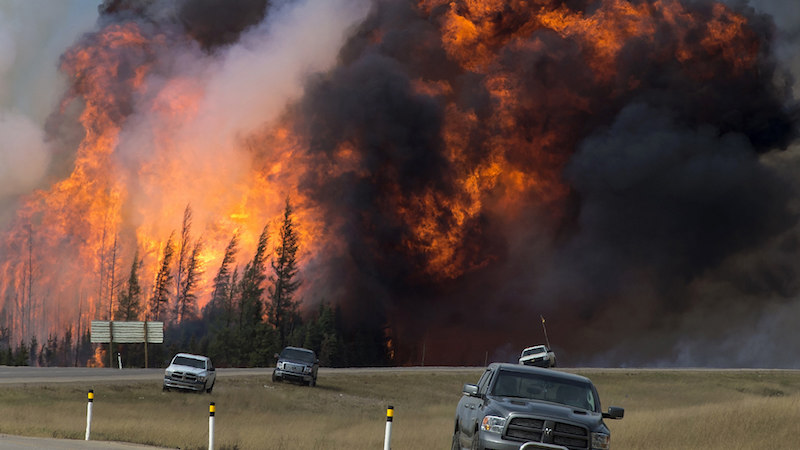Think “not impossible”, rather than “possible”.
“If you would like to stabilise global warming at 1.5C, the key message is that net CO2 emissions at the global scale must reach zero by 2050,“ Valérie Masson-Delmotte, one of co-chairs of the Intergovernmental Panel on Climate Change’s research on the target, said on Monday.
Such a target would require urgent, Herculean changes around the world, criss-crossing the energy, agricultural and transport sectors. Yet, scientists are adamant that countries can limit warming to 1.5C above pre-industrial levels if they can summon up the political will.
“The message is: over to governments at this stage: we’ve told you the scientific facts, the evidence, the cost, it is up to the governments now to decide what to do with it,” Jim Skea, another one of the co-chairs of the report, said.
‘Most important years in history’: UN report sounds last-minute climate alarm
The world will need to flex every institutional and diplomatic muscle it has available.
“Countries will need to collaborate,” he added. “We don’t have a top down agreement at Paris, it’s bottom-up. But they need to take collaborative and coordinated action if we’re actually going to achieve a goal of 1.5 degrees warming.”
“Saying option x or option y is not the way this report is framed,” Skea said. “The word ‘or’ does not work in relation to the ambition of 1.5 warming. The only linking word you can use is ‘and’. We can make choices about how much of each option we use, and trade off a bit between them. But the idea you can leave anything out is not possible.”
That means going gang busters for renewables and reforestation, but also using unproven technologies, such as carbon capture and storage, and some that are even less developed, like direct air capture, or enhanced weathering of rocks.
What happens in the next few months will impact the future of the Paris Agreement and the global climate
CHN will be there keeping you informed from the inside.
If you value our coverage, please consider helping us. Become a CHN patron for as little as $5 per month.
We have set up a Patreon account. It’s a simple, safe and easy way for you to become part of a community that will secure and guide our future.
Thank you!
Whether or not certain individual countries can go net zero by 2050 is another matter. Among developing countries, China and India are key. According to the International Energy Agency, China was the largest carbon emitter in 2015, coughing out 28% of the world’s emissions. Coming third after the United States, India accounted for 6% of the CO2 pie.
Scientists are divided over their potential to wean themselves off carbon by 2050.
Roberto Schaeffer, one of the authors of the report focusing on sustainable development, ruled out a net zero scenario by 2050 for both countries.
“Probably the only countries that, perhaps, can get to zero by, or right after, 2050 are the ones with high potential for afforestation, reforestation, soil gains, pasture intensification, and biofuels with carbon capture and storage [Beccs],” he said.
“Brazil, other parts of Latin America, and parts of Africa may be good candidates for that. But probably not China or India.”
Like Schaeffer, report author Diana Ürge-Vorsatz raised concerns about India’s reliance on coal. However, she stressed the country could likely go net zero “very soon after”, providing solutions like Beccs that allow negative emissions are in place.
China’s economic reforms are the “most forward looking” around, Ürge-Vorsatz said. According to research by the University of East Anglia, emissions may have already peaked before its Paris pledge.
Other governments are moving in the opposite direction. In the US, Australia and now seemingly Brazil, leaders are set to actively undermine progress just when scientists say the world needs to accelerate as one. In response, authors and campaigners urged individuals and non-state actors to take a step forward for every one backward by governments.
Masson-Delmotte highlighted lifestyle choices as “important elements of feasibility”, citing the impact of diet on land use. Skea also reminds of the potential for travel behaviour to sway emissions in the aviation industry.
Individuals, states, regions, cities and companies all need to take climate change seriously, said Jennifer Morgan, executive director of Greenpeace.
“In a world where there are governments that are not delivering, the pressure on those non-state actors is going to grow,” she said.

Graphic from the IPCC’s special report on 1.5C
There have been myriad ‘subnational’ climate initiatives in response to Donald Trump’s decision to withdraw from the Paris Agreement. New York, which pledged in September to invest $4 billion of its pension funds into climate-focused projects, is but one example of local leadership on climate change.
Morgan asked what feasibility really meant and who non-action on climate change was feasible for? “The report spells out quite clearly who loses from climate change,” she said “It’s the vulnerable and poor. That’s quite a choice.”
“Decision makers also need to think the feasibility of living in a world of living above 1.5C. That’s 420m people frequently exposed to heatwaves. And 2 million people exposed to sea-level rise,” she said.
“It’s really important that people understand that this report gives us hope,” Rueanna Haynes, a delegate to the IPCC meeting for St Kitts and Nevis, one of the Carribean islands gravely exposed to climate impacts, said. “I’ve heard people interpret it as almost giving us a basis to say: What’s the point? It can never be done.
“But for us this report is telling us: Yes, this situation is a difficult one. Yes, the situation is only going to get worse. But we have choices and there are options, and the report sets out the timeframe in which we need to act over the next 30 years. We have to act.”
